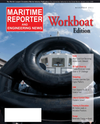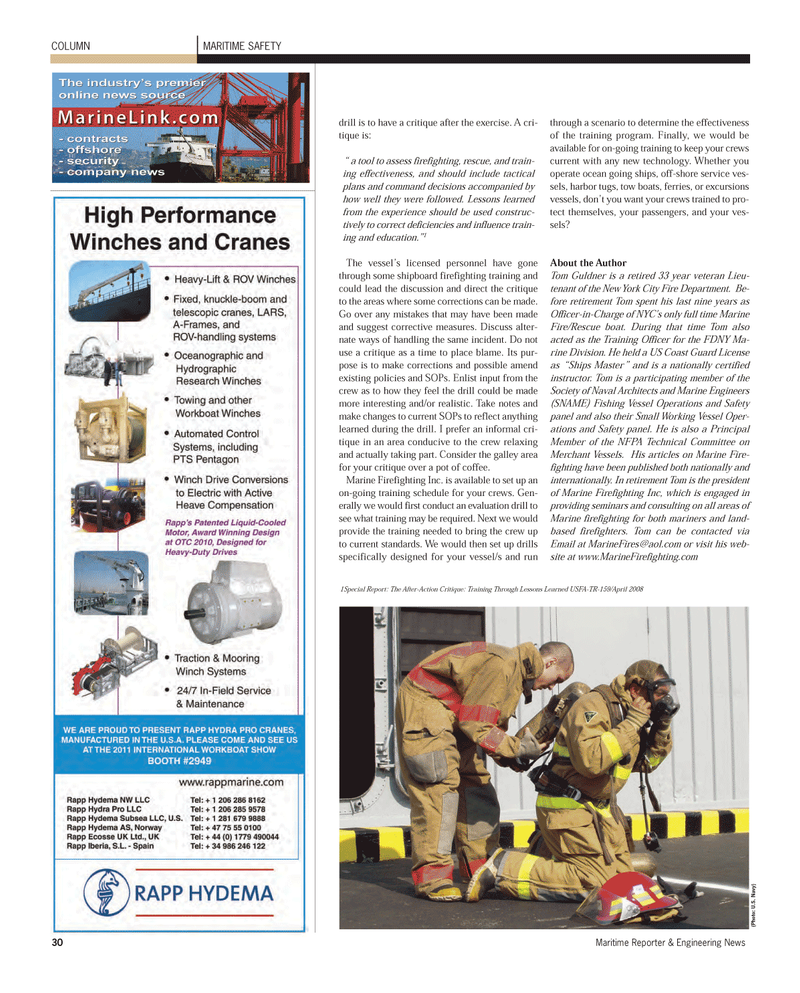
Page 30: of Maritime Reporter Magazine (November 2011)
Feature: Workboat Annual
Read this page in Pdf, Flash or Html5 edition of November 2011 Maritime Reporter Magazine
drill is to have a critique after the exercise. A cri- tique is:? a tool to assess firefighting, rescue, and train- ing effectiveness, and should include tactical plans and command decisions accompanied byhow well they were followed. Lessons learned from the experience should be used construc- tively to correct deficiencies and influence train- ing and education.? 1 The vessel?s licensed personnel have gone through some shipboard firefighting training and could lead the discussion and direct the critiqueto the areas where some corrections can be made.Go over any mistakes that may have been made and suggest corrective measures. Discuss alter- nate ways of handling the same incident. Do not use a critique as a time to place blame. Its pur- pose is to make corrections and possible amend existing policies and SOPs. Enlist input from the crew as to how they feel the drill could be made more interesting and/or realistic. Take notes and make changes to current SOPs to reflect anything learned during the drill. I prefer an informal cri-tique in an area conducive to the crew relaxing and actually taking part. Consider the galley area for your critique over a pot of coffee. Marine Firefighting Inc. is available to set up an on-going training schedule for your crews. Gen- erally we would first conduct an evaluation drill to see what training may be required. Next we would provide the training needed to bring the crew up to current standards. We would then set up drills specifically designed for your vessel/s and run through a scenario to determine the effectiveness of the training program. Finally, we would be available for on-going training to keep your crews current with any new technology. Whether you operate ocean going ships, off-shore service ves- sels, harbor tugs, tow boats, ferries, or excursions vessels, don?t you want your crews trained to pro- tect themselves, your passengers, and your ves- sels?About the Author Tom Guldner is a retired 33 year veteran Lieu- tenant of the New York City Fire Department. Be- fore retirement Tom spent his last nine years as Officer-in-Charge of NYC's only full time Marine Fire/Rescue boat. During that time Tom also acted as the Training Officer for the FDNY Ma- rine Division. He held a US Coast Guard License as ?Ships Master? and is a nationally certified instructor. Tom is a participating member of the Society of Naval Architects and Marine Engineers (SNAME) Fishing Vessel Operations and Safety panel and also their Small Working Vessel Oper- ations and Safety panel. He is also a PrincipalMember of the NFPA Technical Committee on Merchant Vessels. His articles on Marine Fire- fighting have been published both nationally and internationally. In retirement Tom is the president of Marine Firefighting Inc, which is engaged in providing seminars and consulting on all areas of Marine firefighting for both mariners and land- based firefighters. Tom can be contacted via Email at [email protected] or visit his web- site at www.MarineFirefighting.com COLUMNMARITIME SAFETY(Photo: U.S. Navy)1Special Report: The After-Action Critique: Training Through Lessons Learned USFA-TR-159/April 2008 30Maritime Reporter & Engineering News MR Nov.11 # 4 (25-33):MR Template 10/27/2011 9:19 AM Page 30

 29
29

 31
31
